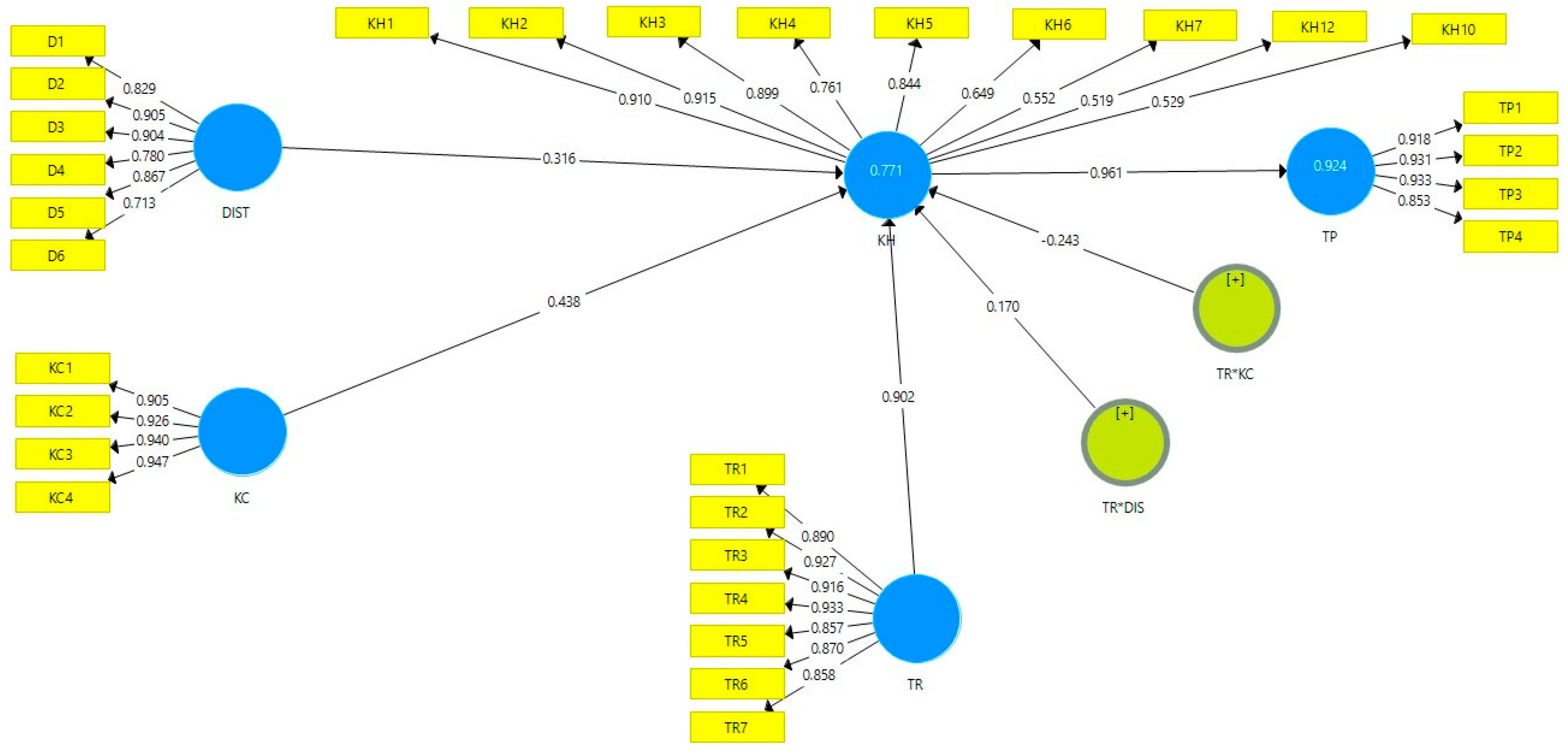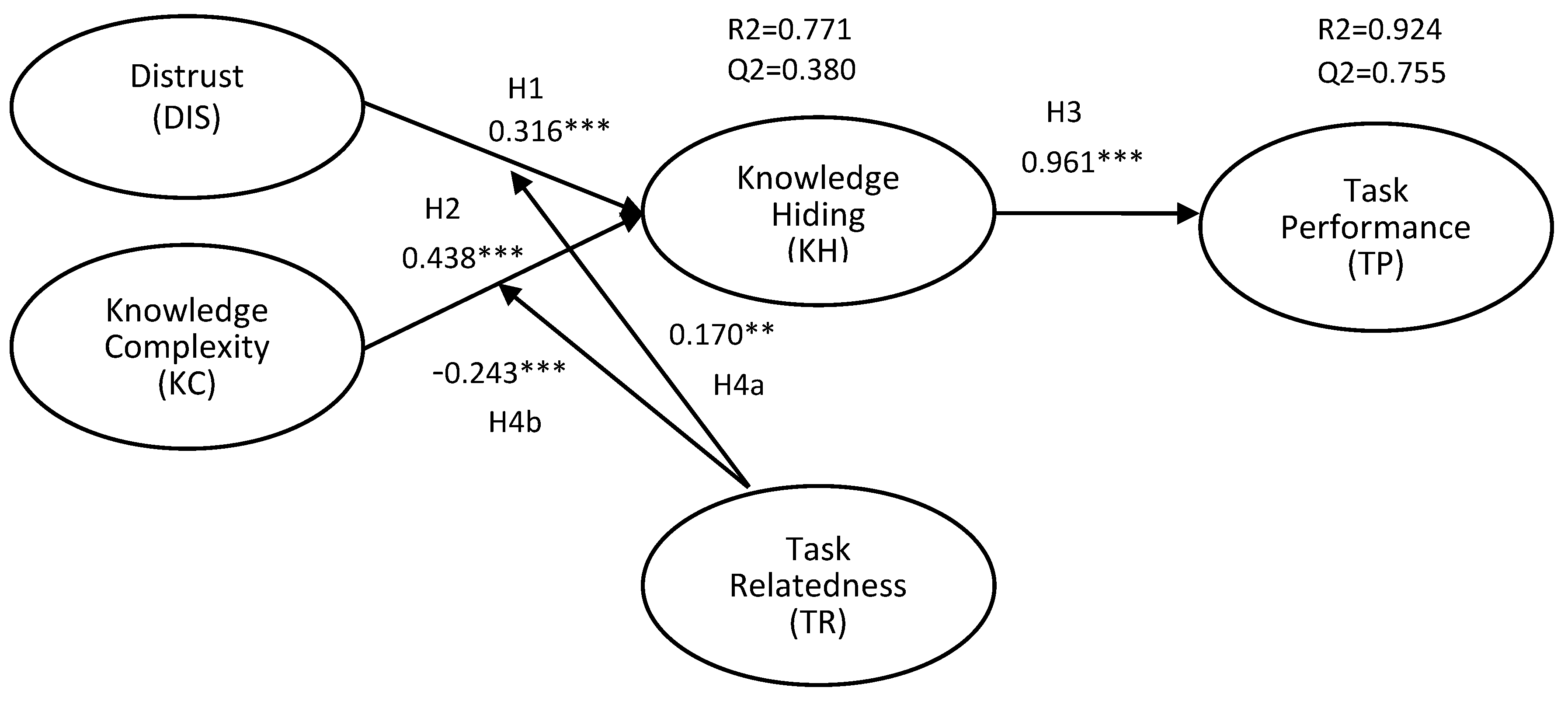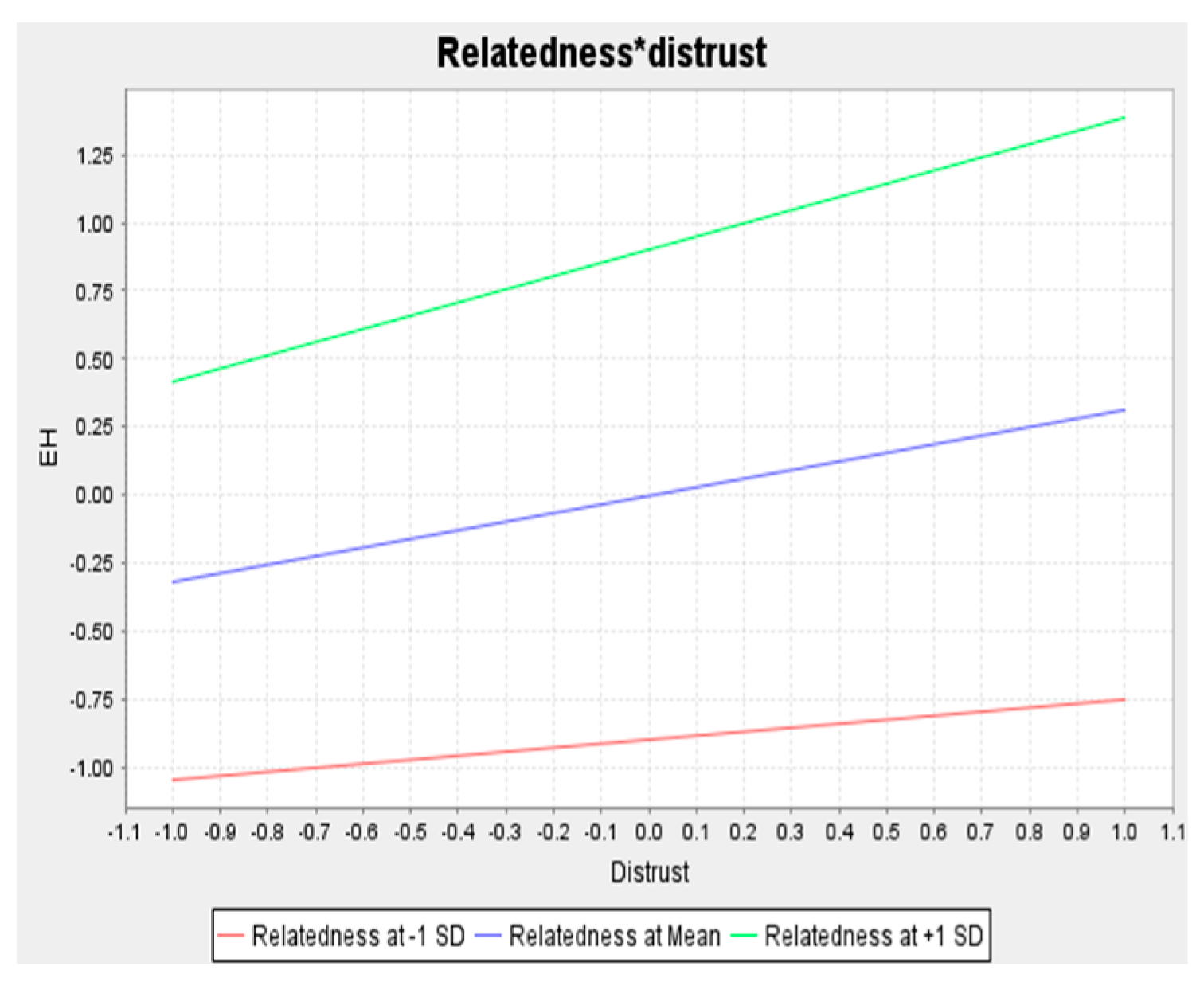Why and When Do Employees Hide Their Knowledge?
Abstract
:1. Introduction
2. Literature Review and Hypothesis Development
2.1. Knowledge Hiding (KH)
2.2. Distrust (DIS) and Knowledge Hiding (KH)
2.3. Knowledge Complexity (KC) and Knowledge Hiding (KH)
2.4. Knowledge Hiding (KH) and Task Performance (TP)
2.5. The Moderating Role of Task Relatedness (TR)
3. Research Methods
3.1. Sample and Data Collection
3.2. Measures
4. Results
4.1. Validity and Reliability
4.2. Hypothesis Testing
4.2.1. Direct Effect
4.2.2. Moderating Effects
5. Discussions
Practical Implications
6. Conclusions and Limitations
6.1. Conclusions
6.2. Limitations and Future Research
Author Contributions
Funding
Institutional Review Board Statement
Informed Consent Statement
Data Availability Statement
Conflicts of Interest
Appendix A
| Construct | Items | Variables | References |
|---|---|---|---|
| Distrust (DIS) | I fear THEIR future decisions. | D1 | [42] |
| I am cynical toward them. | D2 | ||
| THEY must be monitored. | D3 | ||
| I must remain vigilant when dealing with THEM. | D4 | ||
| I am wary of THEM. | D5 | ||
| I must remain watchful of my transactions with THEM. | D6 | ||
| Knowledge Complexity (KC) | The knowledge used in your organization requires prior learning in other technologies and related knowledge. | KC1 | [43] |
| Description of the knowledge used in your organization requires a large amount of information. | KC2 | ||
| The knowledge used in your organization is technologically sophisticated and difficult to implement. | KC3 | ||
| The knowledge used in your organization is complex. | KC4 | ||
| Task Relatedness (TR) | Other people’s work depends directly on my job. | TR1 | [44] |
| Unless my job gets done, other sections cannot do their work. | TR2 | ||
| Unsatisfactory performance of my job would delay the work performance of other people. | TR3 | ||
| I provide other people with the help or advice they need to do their work. | TR4 | ||
| I provide other people with materials, tools, or supplies which they need to do their work. | TR5 | ||
| I provide other people with information they need to do their work. | TR6 | ||
| I provide support services which other people need to do their work. | TR7 | ||
| Knowledge Hiding (KH) | Agreed to help him/her but never really intended to. | KH1 | [1] |
| Agreed to help him/her but instead gave him/her information different from what she/he wanted. | KH2 | ||
| Told him/her that I would help him/her out later but stalled as much as possible. | KH3 | ||
| Offered him/her some other information instead of what he/she really wanted. | KH4 | ||
| Pretended that I did not know the information. | KH5 | ||
| Said that I did not know, even though I did. | KH6 | ||
| Pretended I did not know what she/he was talking about. | KH7 | ||
| Said that I was not very knowledgeable about the topic. | KH8 | ||
| Explained that I would like to tell him/her, but was not supposed to. | KH9 | ||
| Explained that the information is confidential and only available to people on a particular project. | KH10 | ||
| Told him/her that my boss would not let anyone share this knowledge. | KH11 | ||
| Said that I would not answer his/her questions. | KH12 |
References
- Connelly, C.E.; Zweig, D.; Webster, J.; Trougakos, J.P. Knowledge hiding in organizations. J. Organ. Behav. 2012, 33, 64–88. [Google Scholar] [CrossRef]
- Singh, S.K. Territoriality, task performance, and workplace deviance: Empirical evidence on role of knowledge hiding. J. Bus. Res. 2019, 97, 10–19. [Google Scholar] [CrossRef]
- Anand, A.; Centobelli, P.; Cerchione, R. Why should I share knowledge with others? A review-based framework on events leading to knowledge hiding. J. Organ. Chang. Manag. 2020, 33, 379–399. [Google Scholar] [CrossRef]
- Burmeister, A.; Fasbender, U.; Gerpott, F.H. Consequences of knowledge hiding: The differential compensatory effects of guilt and shame. J. Occup. Organ. Psychol. 2019, 92, 281–304. [Google Scholar] [CrossRef]
- Hernaus, T.; Cerne, M.; Connelly, C.; Vokic, N.P.; Škerlavaj, M. Evasive knowledge hiding in academia: When competitive individuals are asked to collaborate. J. Knowl. Manag. 2019, 23, 597–618. [Google Scholar] [CrossRef]
- El-Kassar, A.-N.; Dagher, G.K.; Lythreatis, S.; Azakir, M. Antecedents and consequences of knowledge hiding: The roles of HR practices, organizational support for creativity, creativity, innovative work behavior, and task performance. J. Bus. Res. 2022, 140, 1–10. [Google Scholar] [CrossRef]
- Ain, N.U.; Azeem, M.U.; Sial, M.H.; Arshad, M.A. Linking knowledge hiding to extra-role performance: The role of emotional exhaustion and political skills. Knowl. Manag. Res. Pract. 2021, 1–14. [Google Scholar] [CrossRef]
- Černe, M.; Nerstad, C.G.L.; Dysvik, A.; Škerlavaj, M. What goes around comes around: Knowledge hiding, perceived motivational climate, and creativity. Acad. Manag. J. 2014, 57, 172–192. [Google Scholar] [CrossRef]
- Duan, Y.; Yang, M.; Huang, L.; Chin, T.; Fiano, F.; de Nuccio, E.; Zhou, L. Unveiling the impacts of explicit vs. tacit knowledge hiding on innovation quality: The moderating role of knowledge flow within a firm. J. Bus. Res. 2022, 139, 1489–1500. [Google Scholar] [CrossRef]
- Fong, P.S.W.; Men, C.; Luo, J.; Jia, R. Knowledge hiding and team creativity: The contingent role of task interdependence. Manag. Decis. 2018, 56, 329–343. [Google Scholar] [CrossRef]
- Connelly, C.E.; Zweig, D. How perpetrators and targets construe knowledge hiding in organizations. Eur. J. Work Organ. Psychol. 2015, 24, 479–489. [Google Scholar] [CrossRef]
- Banagou, M.; Batistič, S.; Do, H.; Poell, R.F. Relational climates moderate the effect of openness to experience on knowledge hiding: A two-country multi-level study. J. Knowl. Manag. 2021, 25, 60–87. [Google Scholar] [CrossRef]
- Zhao, H.; Xia, Q.; He, P.; Sheard, G.; Wan, P. Workplace ostracism and knowledge hiding in service organizations. Int. J. Hosp. Manag. 2016, 59, 84–94. [Google Scholar] [CrossRef]
- Wang, Y.; Han, M.S.; Xiang, D.; Hampson, D.P. The double-edged effects of perceived knowledge hiding: Empirical evidence from the sales context. J. Knowl. Manag. 2019, 23, 279–296. [Google Scholar] [CrossRef]
- Khoreva, V.; Wechtler, H. Exploring the consequences of knowledge hiding: An agency theory perspective. J. Manag. Psychol. 2020, 35, 71–84. [Google Scholar] [CrossRef]
- Alnaimi, A.M.M.; Rjoub, H. Perceived organizational support, psychological entitlement, and extra-role behavior: The mediating role of knowledge hiding behavior. J. Manag. Organ. 2021, 27, 507–522. [Google Scholar] [CrossRef]
- Han, M.S.; Masood, K.; Cudjoe, D.; Wang, Y. Knowledge hiding as the dark side of competitive psychological climate. Leadersh. Organ. Dev. J. 2020, 42, 195–207. [Google Scholar] [CrossRef]
- Arain, G.A.; Bhatti, Z.A.; Ashraf, N.; Fang, Y.-H. Top-down knowledge hiding in organizations: An empirical study of the consequences of supervisor knowledge hiding among local and foreign workers in the Middle East. J. Bus. Ethics 2020, 164, 611–625. [Google Scholar] [CrossRef] [Green Version]
- Issac, A.C.; Baral, R.; Bednall, T.C. Don’t play the odds, play the man. Eur. Bus. Rev. 2020, 32, 531–551. [Google Scholar] [CrossRef]
- Agarwal, U.A.; Avey, J.; Wu, K. How and when abusive supervision influences knowledge hiding behavior: Evidence from India. J. Knowl. Manag. 2022, 26, 209–231. [Google Scholar] [CrossRef]
- Jiang, Z.; Hu, X.; Wang, Z.; Jiang, X. Knowledge hiding as a barrier to thriving: The mediating role of psychological safety and moderating role of organizational cynicism. J. Organ. Behav. 2019, 40, 800–818. [Google Scholar] [CrossRef]
- Gagné, M.; Tian, A.W.; Soo, C.; Zhang, B.; Ho, K.S.B.; Hosszu, K. Different motivations for knowledge sharing and hiding: The role of motivating work design. J. Organ. Behav. 2019, 40, 783–799. [Google Scholar] [CrossRef]
- Xiao, M.; Cooke, F.L. Why and when knowledge hiding in the workplace is harmful: A review of the literature and directions for future research in the Chinese context. Asia Pac. J. Hum. Resour. 2019, 57, 470–502. [Google Scholar] [CrossRef]
- Campbell, E.G.; Weissman, J.S.; Causino, N.; Blumenthal, D. Data withholding in academic medicine: Characteristics of faculty denied access to research results and biomaterials. Res. Policy 2000, 29, 303–312. [Google Scholar] [CrossRef]
- Ford, D.P.; Staples, S. Are full and partial knowledge sharing the same? J. Knowl. Manag. 2010, 14, 394–409. [Google Scholar] [CrossRef]
- Connelly, C.E.; Černe, M.; Dysvik, A.; Škerlavaj, M. Understanding knowledge hiding in organizations. J. Organ. Behav. 2019, 40, 779–782. [Google Scholar] [CrossRef]
- Kumar Jha, J.; Varkkey, B. Are you a cistern or a channel? Exploring factors triggering knowledge-hiding behavior at the workplace: Evidence from the Indian R&D professionals. J. Knowl. Manag. 2018, 22, 824–849. [Google Scholar] [CrossRef]
- Pan, W.; Zhang, Q. A study on motivations of graduate students’ knowledge hiding based on wuli-shili-renli system approach. Nat. Sci. 2014, 27, 36. [Google Scholar]
- Serenko, A.; Bontis, N. Understanding counterproductive knowledge behavior: Antecedents and consequences of intra-organizational knowledge hiding. J. Knowl. Manag. 2016, 20, 1199–1224. [Google Scholar] [CrossRef]
- Khalid, M.; Gulzar, A.; Karim Khan, A. When and how the psychologically entitled employees hide more knowledge? Int. J. Hosp. Manag. 2020, 89, 102413. [Google Scholar] [CrossRef]
- Venz, L.; Nesher Shoshan, H. Be smart, play dumb? A transactional perspective on day-specific knowledge hiding, interpersonal conflict, and psychological strain. Hum. Relat. 2021, 75, 113–138. [Google Scholar] [CrossRef]
- Nguyen, T.-M.; Malik, A.; Budhwar, P. Knowledge hiding in organizational crisis: The moderating role of leadership. J. Bus. Res. 2022, 139, 161–172. [Google Scholar] [CrossRef] [PubMed]
- Yuan, Y.; Yang, L.; Cheng, X.; Wei, J. What is bullying hiding? Exploring antecedents and potential dimension of knowledge hiding. J. Knowl. Manag. 2020, 25, 1146–1169. [Google Scholar] [CrossRef]
- Blau, P.M. Exchange and Power in Social Life; Routledge: London, UK, 2017. [Google Scholar]
- Collins, B.J. Fair? I don’t care: Examining the moderating effect of workplace cynicism on the relationship between interactional fairness and perceptions of organizational support from a social exchange perspective. J. Leadersh. Organ. Stud. 2017, 24, 401–413. [Google Scholar] [CrossRef]
- Khan, M.A.; Malik, O.F.; Shahzad, A. Social undermining and employee creativity: The mediating role of interpersonal distrust and knowledge hiding. Behav. Sci. 2022, 12, 25. [Google Scholar] [CrossRef]
- Scuotto, V.; Nespoli, C.; Tran, P.T.; Cappiello, G. An alternative way to predict knowledge hiding: The lens of transformational leadership. J. Bus. Res. 2022, 140, 76–84. [Google Scholar] [CrossRef]
- Peng, J.; Wang, Z.; Chen, X. Does self-serving leadership hinder team creativity? A moderated dual-path model. J. Bus. Ethics 2019, 159, 419–433. [Google Scholar] [CrossRef]
- Zhang, Z.; Min, M.; Cai, X.; Qiu, H. Mitigating the negative performance effect of project complexity through an informal mechanism: The conditional mediating role of knowledge hiding. Int. J. Proj. Manag. 2022, in press. [Google Scholar] [CrossRef]
- Jafari-Sadeghi, V.; Amoozad Mahdiraji, H.; Devalle, A.; Pellicelli, A.C. Somebody is hiding something: Disentangling interpersonal level drivers and consequences of knowledge hiding in international entrepreneurial firms. J. Bus. Res. 2022, 139, 383–396. [Google Scholar] [CrossRef]
- Sekaran, U.; Bougie, R. Research Methods for Business: A Skill Building Approach; John Wiley & Sons: Hoboken, NJ, USA, 2016. [Google Scholar]
- Lewicki, R.J.; McAllister, D.J.; Bies, R.J. Trust and distrust: New relationships and realities. Acad. Manag. Rev. 1998, 23, 438–458. [Google Scholar] [CrossRef]
- Pérez-Luño, A.; Alegre, J.; Valle-Cabrera, R. The role of tacit knowledge in connecting knowledge exchange and combination with innovation. Technol. Anal. Strateg. Manag. 2019, 31, 186–198. [Google Scholar] [CrossRef]
- Pierce, J.L.; Rubenfeld, S.A.; Morgan, S. Employee ownership: A conceptual model of process and effects. Acad. Manag. Rev. 1991, 16, 121–144. [Google Scholar] [CrossRef]
- Hair, J.F.; Hult, T.M.; Ringle, C.M.; Sarstedt, M. A Primer on Partial Least Squares Structural Equation Modeling (PLS-SEM); Sage Publications, Inc.: London, UK, 2016. [Google Scholar]
- Henseler, J.; Ringle, C.M.; Sarstedt, M. A new criterion for assessing discriminant validity in variance-based structural equation modeling. J. Acad. Mark. Sci. 2015, 43, 115–135. [Google Scholar] [CrossRef] [Green Version]
- Hui-Wen Chuah, S.; Sujanto, R.Y.; Sulistiawan, J.; Cheng-Xi Aw, E. What is holding customers back? Assessing the moderating roles of personal and social norms on CSR’S routes to Airbnb repurchase intention in the COVID-19 era. J. Hosp. Tour. Manag. 2022, 50, 67–82. [Google Scholar] [CrossRef]




| Demographic | Classifications | Frequency | Percentage |
|---|---|---|---|
| Gender | Male | 165 | 50.8% |
| Female | 160 | 49.2% | |
| Age | 18–27 years old | 186 | 57.2% |
| 28–34 years old | 98 | 30.2% | |
| 35–41 years old | 27 | 8.3% | |
| Above 41 years old | 15 | 4.6% | |
| Employment status | Full-time | 230 | 70.8% |
| Part-time | 95 | 29.2% | |
| Tenure | Less than 1 year | 74 | 22.8% |
| 1–2 years | 157 | 48.3% | |
| 2–4 years | 80 | 24.6% | |
| Above 4 years | 15 | 4.6% |
| Variable | Indicators | Loading Factor | t | AVE | α | CR |
|---|---|---|---|---|---|---|
| Knowledge Hiding (KH) | KH1 | 0.910 | 62.480 | 0.628 | 0.888 | 0.903 |
| KH2 | 0.915 | 65.943 | ||||
| KH3 | 0.899 | 44.052 | ||||
| KH4 | 0.761 | 14.201 | ||||
| KH5 | 0.844 | 32.667 | ||||
| KH6 | 0.649 | 10.259 | ||||
| KH7 | 0.552 | 5.707 | ||||
| KH12 | 0.519 | 4.822 | ||||
| KH10 | 0.529 | 5.352 | ||||
| Distrust (DIS) | D1 | 0.829 | 25.040 | 0.699 | 0.913 | 0.933 |
| D2 | 0.905 | 71.207 | ||||
| D3 | 0.904 | 77.275 | ||||
| D4 | 0.780 | 25.122 | ||||
| D5 | 0.867 | 34.177 | ||||
| D6 | 0.713 | 20.983 | ||||
| Knowledge Complexity (KC) | KC1 | 0.905 | 17.156 | 0.864 | 0.947 | 0.962 |
| KC2 | 0.926 | 54.372 | ||||
| KC3 | 0.940 | 54.070 | ||||
| KC4 | 0.947 | 109.292 | ||||
| Task Performance (TP) | TP1 | 0.918 | 79.892 | 0.827 | 0.930 | 0.950 |
| TP2 | 0.931 | 94.290 | ||||
| TP3 | 0.933 | 79.884 | ||||
| TP4 | 0.853 | 25.392 | ||||
| Task Relatedness (TR) | TR1 | 0.890 | 54.671 | 0.798 | 0.958 | 0.965 |
| TR2 | 0.927 | 77.082 | ||||
| TR3 | 0.916 | 72.813 | ||||
| TR4 | 0.933 | 100.938 | ||||
| TR5 | 0.857 | 35.450 | ||||
| TR6 | 0.870 | 31.608 | ||||
| TR7 | 0.858 | 40.673 |
| KH | DIS | KC | TP | TR | |
|---|---|---|---|---|---|
| 1. KH | - | ||||
| 2. DIS | 0.392 | - | |||
| 3. KC | 0.144 | 0.455 | - | ||
| 4. TP | 0.702 | 0.095 | 0.238 | - | |
| 5. TR | 0.323 | 0.321 | 0.754 | 0.440 | - |
| KH | DIS | KC | TP | TR | |
|---|---|---|---|---|---|
| 1. KH | 0.792 | ||||
| 2. DIS | 0.422 | 0.836 | |||
| 3. KC | 0.231 | 0.555 | 0.923 | ||
| 4. TP | 0.762 | 0.196 | 0.315 | 0.909 | |
| 5. TR | 0.439 | 0.497 | 0.824 | 0.550 | 0.893 |
| Hypothesis | β | p-Value | Bias-Corrected 95% CI | Remarks | ||
|---|---|---|---|---|---|---|
| Lower | Upper | |||||
| H1 | DIS→KH | 0.316 | 0.000 | 0.216 | 0.421 | Supported |
| H2 | KC→KH | 0.438 | 0.000 | 0.281 | 0.582 | Supported |
| H3 | KH→TP | 0.961 | 0.000 | 0.946 | 0.973 | Supported |
| H4a | TR*DIS→KH | 0.170 | 0.011 | 0.046 | 0.282 | Not supported |
| H4b | TR*KC→KH | −0.243 | 0.001 | −0.357 | −0.121 | Supported |
Publisher’s Note: MDPI stays neutral with regard to jurisdictional claims in published maps and institutional affiliations. |
© 2022 by the authors. Licensee MDPI, Basel, Switzerland. This article is an open access article distributed under the terms and conditions of the Creative Commons Attribution (CC BY) license (https://creativecommons.org/licenses/by/4.0/).
Share and Cite
Sulistiawan, J.; Moslehpour, M.; Diana, F.; Lin, P.-K. Why and When Do Employees Hide Their Knowledge? Behav. Sci. 2022, 12, 56. https://doi.org/10.3390/bs12020056
Sulistiawan J, Moslehpour M, Diana F, Lin P-K. Why and When Do Employees Hide Their Knowledge? Behavioral Sciences. 2022; 12(2):56. https://doi.org/10.3390/bs12020056
Chicago/Turabian StyleSulistiawan, Jovi, Massoud Moslehpour, Fransisca Diana, and Pei-Kuan Lin. 2022. "Why and When Do Employees Hide Their Knowledge?" Behavioral Sciences 12, no. 2: 56. https://doi.org/10.3390/bs12020056
APA StyleSulistiawan, J., Moslehpour, M., Diana, F., & Lin, P.-K. (2022). Why and When Do Employees Hide Their Knowledge? Behavioral Sciences, 12(2), 56. https://doi.org/10.3390/bs12020056







